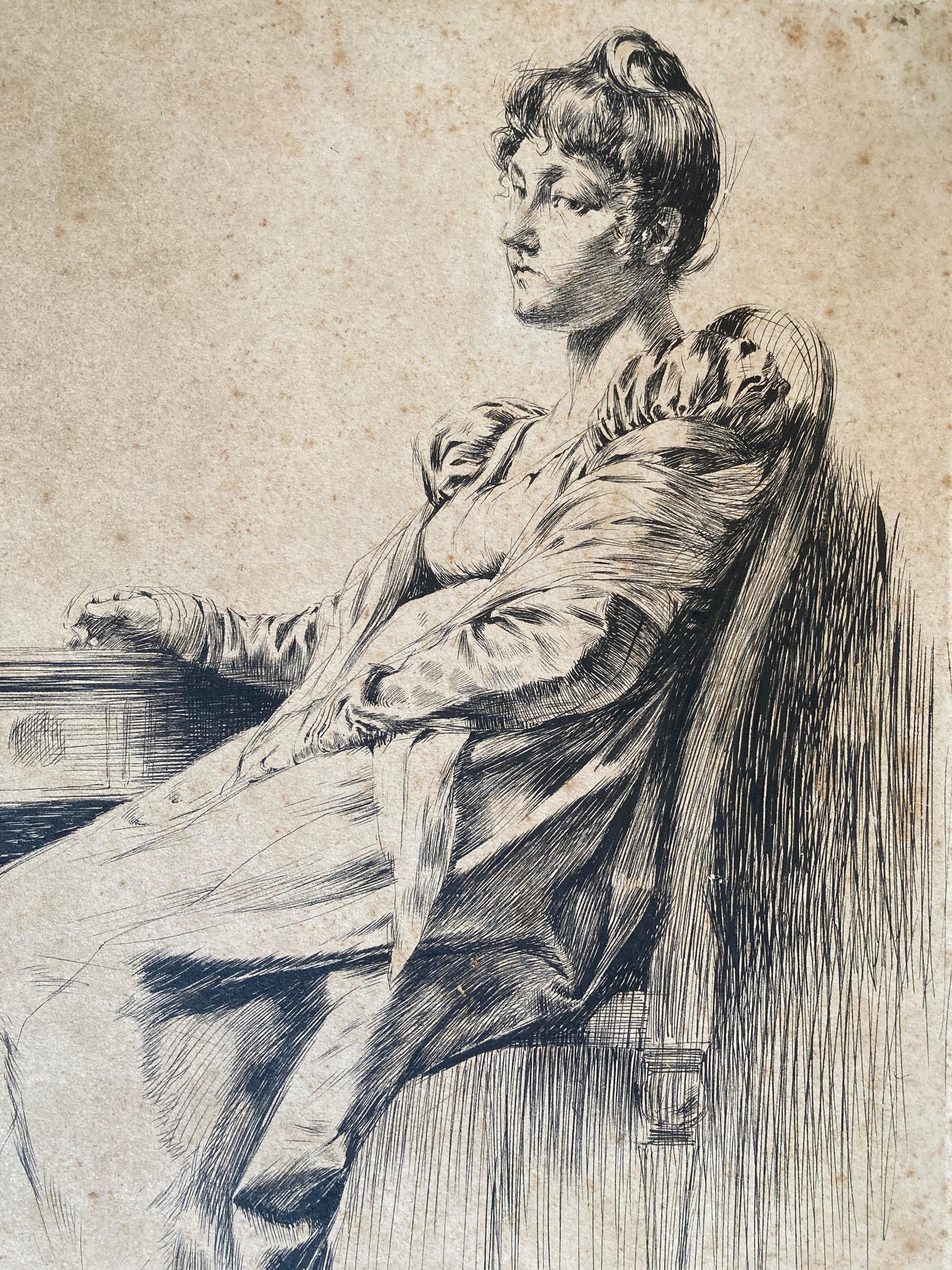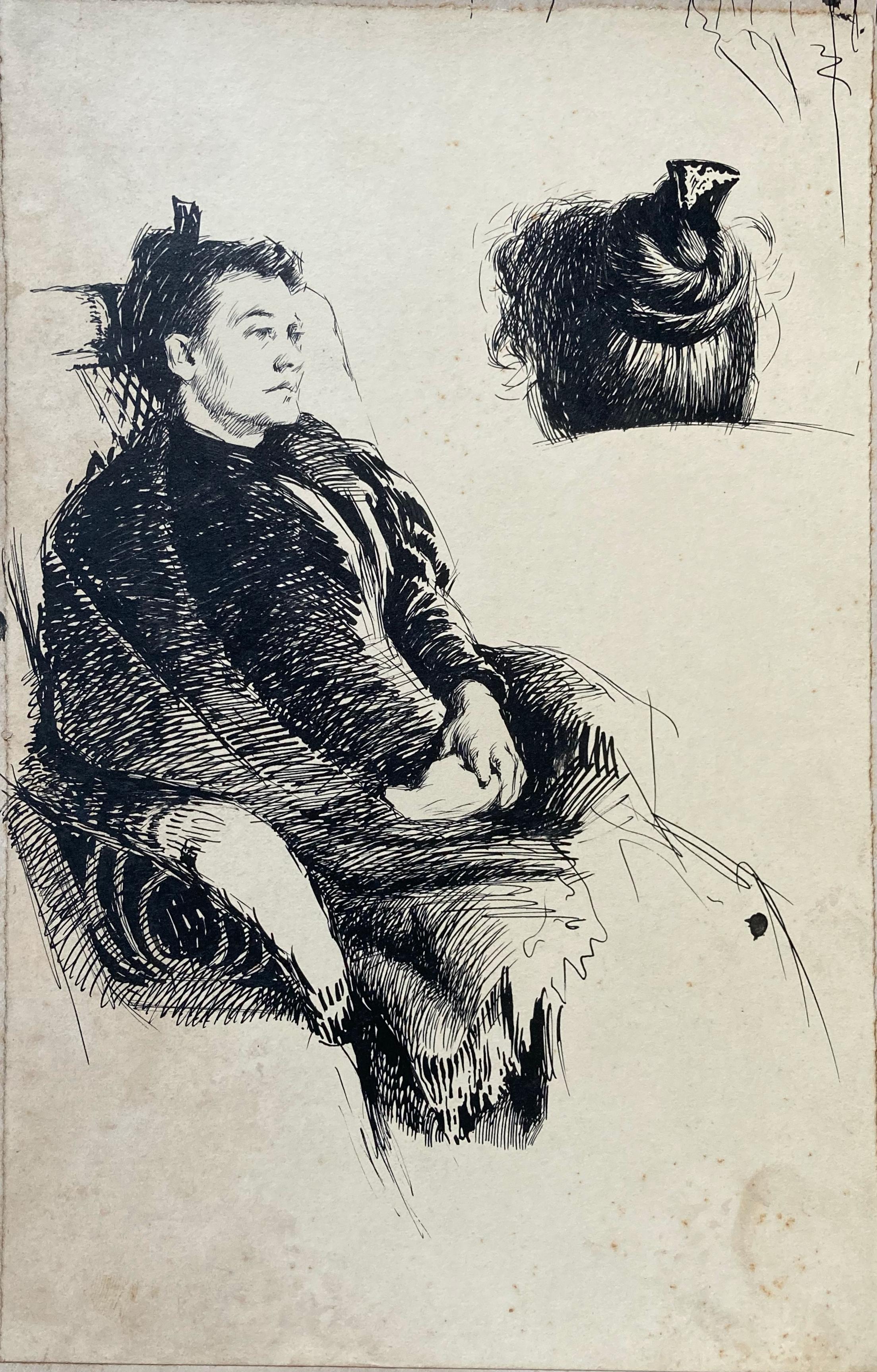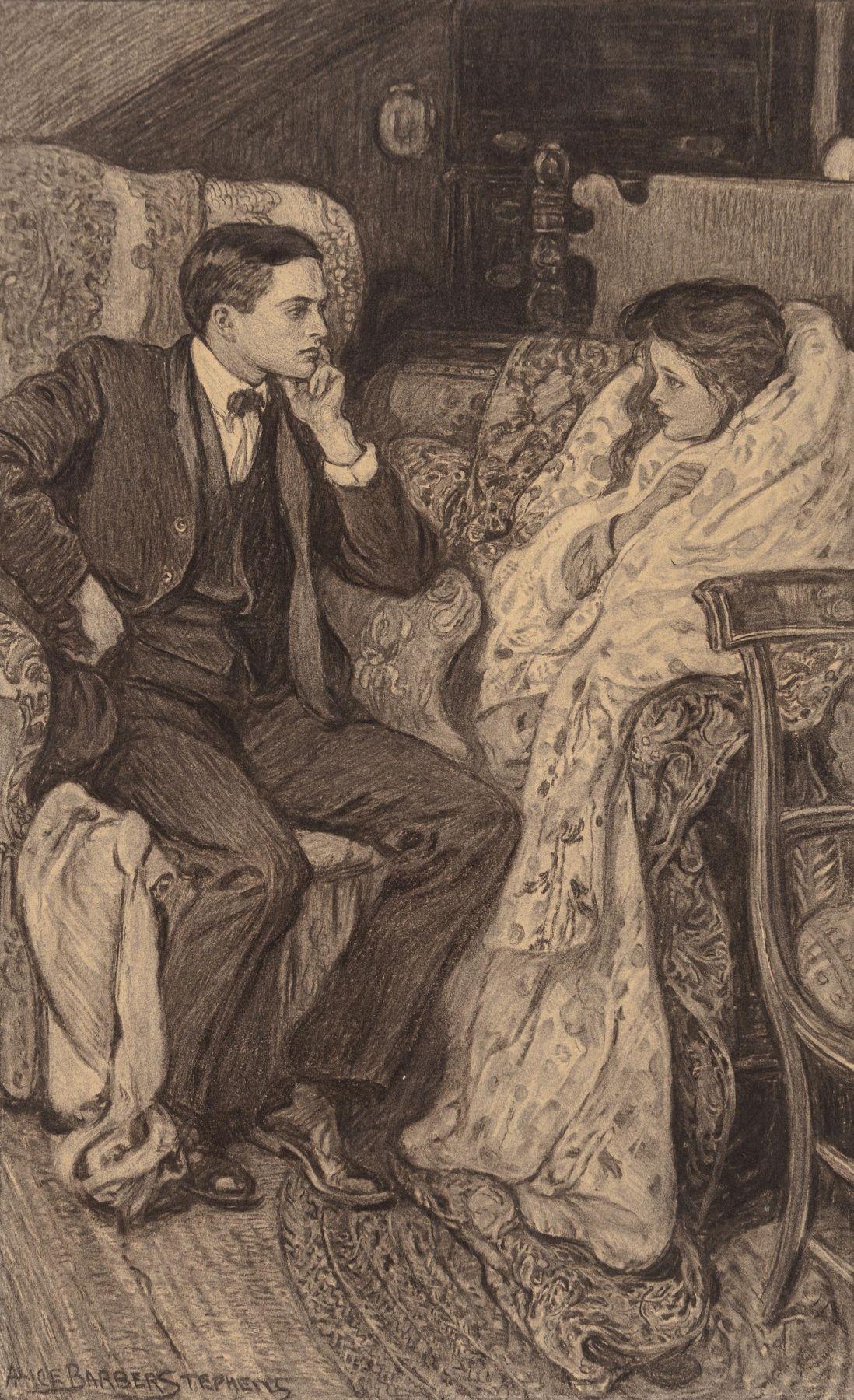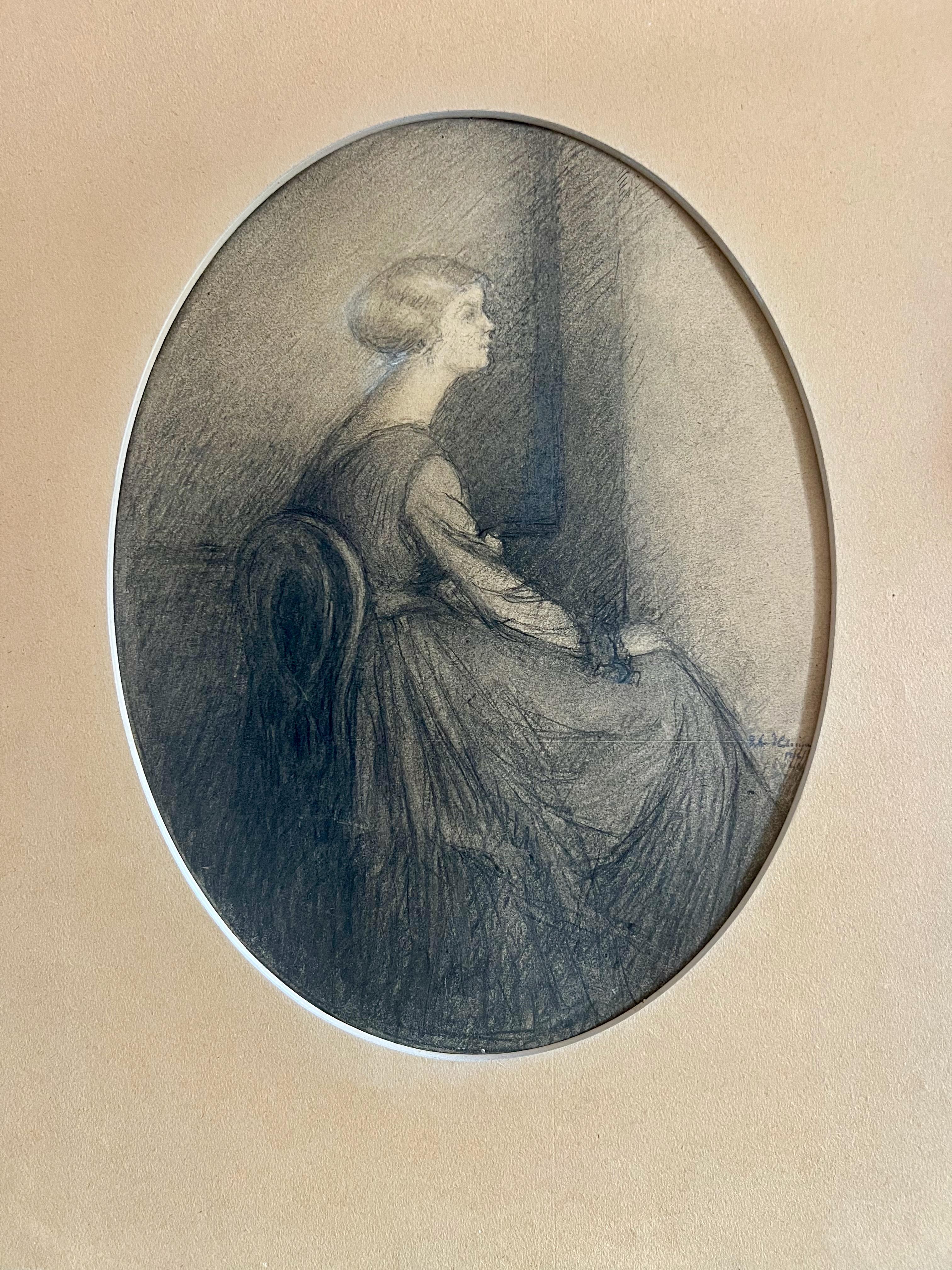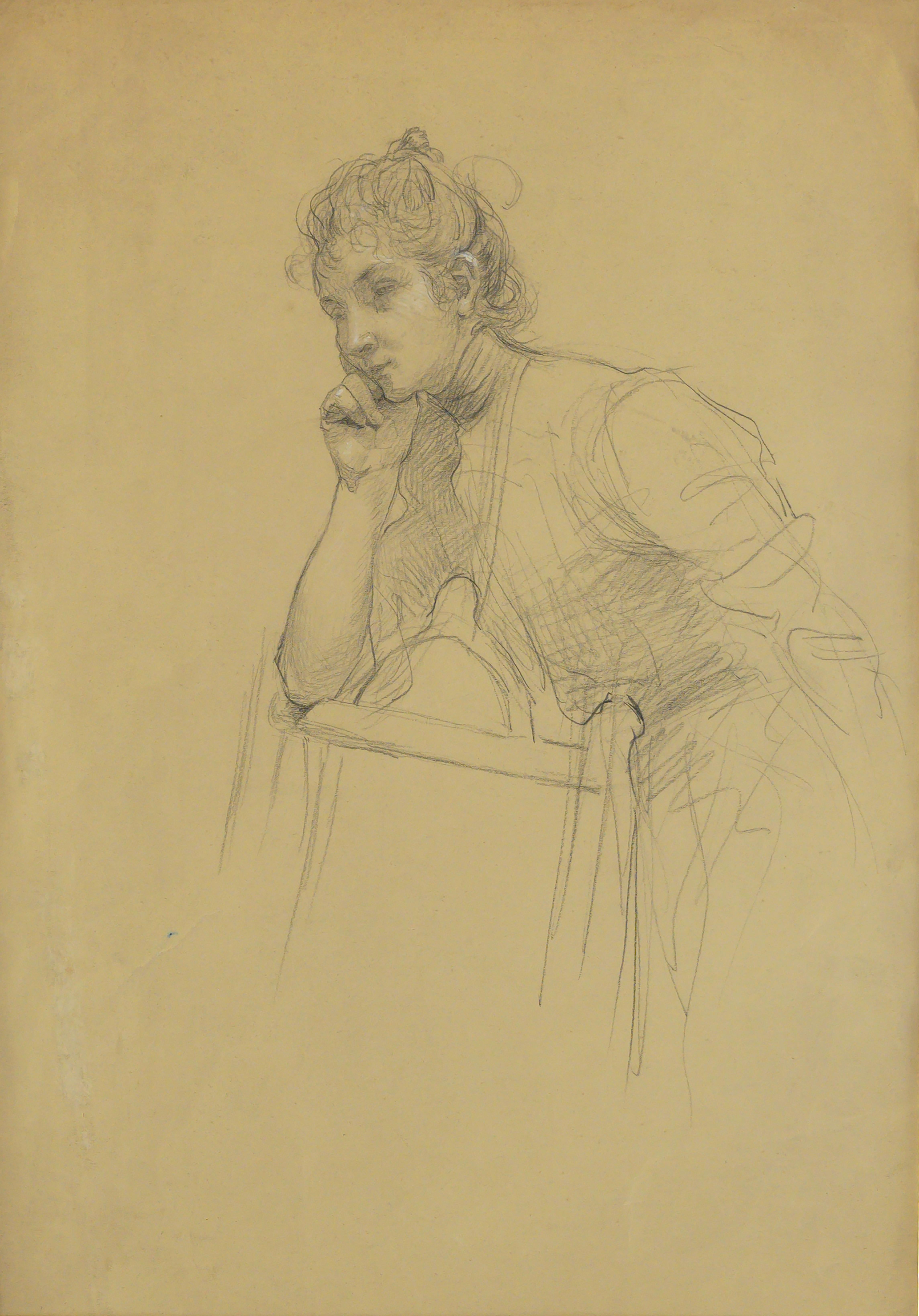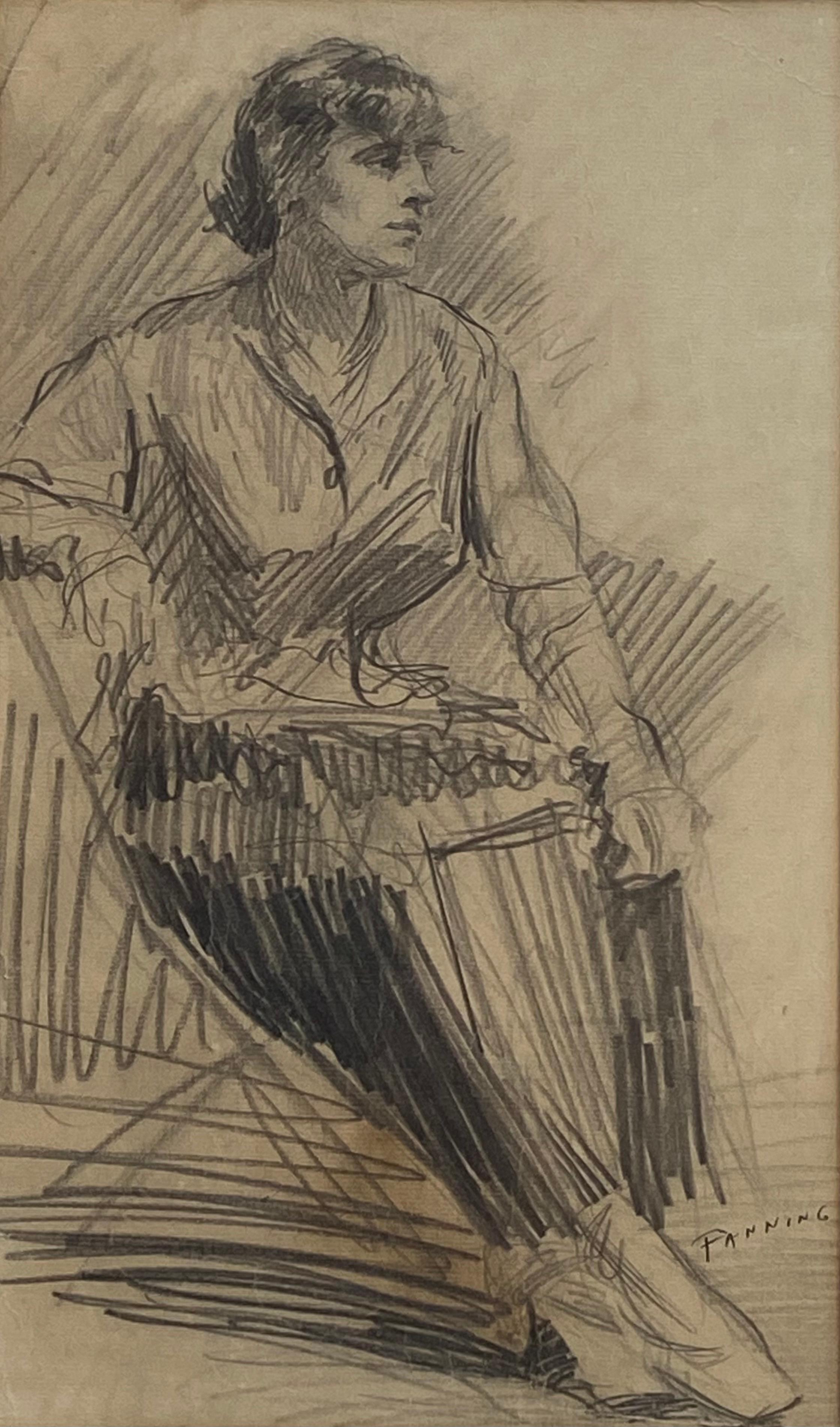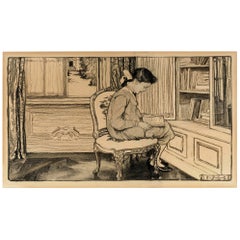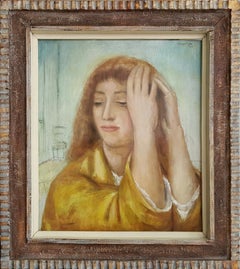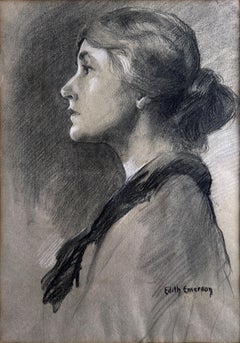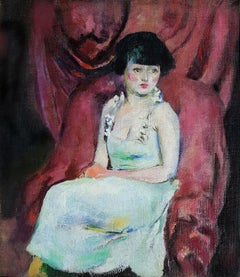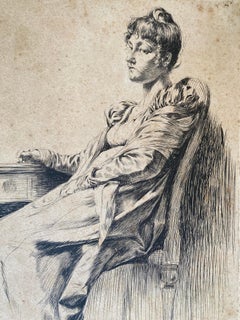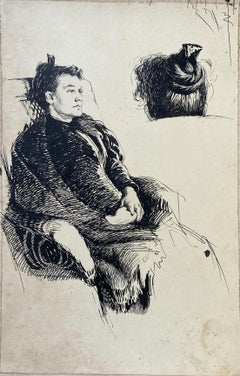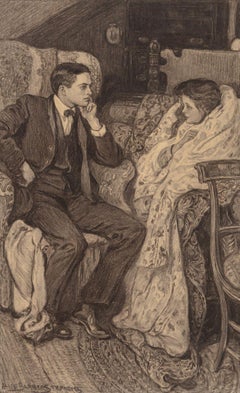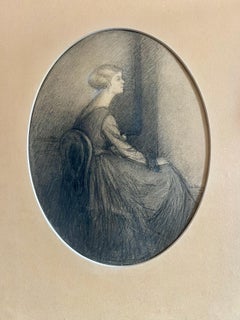Items Similar to Attractive Young Woman Sitting in Chair and Looking Upwards in Domestic Setting
Want more images or videos?
Request additional images or videos from the seller
1 of 14
Alice Barber StephensAttractive Young Woman Sitting in Chair and Looking Upwards in Domestic Settingca. 1905
ca. 1905
$8,000
£6,143.23
€7,047.25
CA$11,240.94
A$12,589.14
CHF 6,568.81
MX$153,770.96
NOK 83,574.35
SEK 78,778.84
DKK 52,592.79
About the Item
Female Illustrator of the Golden Age Alice Barber Stephens renders in an academic style and women sitting in a chair and responding to something outside of the frame.
Signed lower left. Most likely done for a major newsstand magazine like Harper's, Century or Scribner's Monthly.
Work is framed under glass in a simple black wood frame. Perhaps period. Matt is new. Frame size: 20.5 x 14.5
From: Wikipedia
Alice Barber Stephens (July 1, 1858 – July 13, 1932) was an American painter and engraver, best remembered for her illustrations. Her work regularly appeared in magazines such as Scribner's Monthly, Harper's Weekly, and The Ladies Home Journal.
Early life and education
Alice Barber was born near Salem, New Jersey. She was the eighth of nine children born to Samuel Clayton Barber and Mary Owen, who were Quakers.
She attended local schools until she and her family moved to Philadelphia, Pennsylvania. At age 15 she became a student at the Philadelphia School of Design for Women (now Moore College of Art & Design), where she studied wood engraving.
The Women's Life Class (1879), Pennsylvania Academy of the Fine Arts, Philadelphia, Pennsylvania.
She was admitted to the Pennsylvania Academy of the Fine Arts in 1876 (the first year women were admitted), studying under Thomas Eakins. Among her fellow students at the Academy were Susan MacDowell, Frank Stephens, David Wilson Jordan, Lavinia Ebbinghausen, Thomas Anshutz, and Charles H. Stephens (whom she would marry). During this time, at the academy, she began to work with a variety of media, including black-and-white oils, ink washes, charcoal, full-color oils, and watercolors. In 1879, Eakins chose Stephens to illustrate an Academy classroom scene for Scribner's Monthly. The resulting work, Women's Life Class, was Stephens' first illustration credit.
New Woman
As educational opportunities were made more available in the nineteenth century, women artists became part of professional enterprises, including founding their own art associations. Artwork made by women was considered to be inferior by the art world, and to help overcome that stereotype women became "increasingly vocal and confident" in promoting women's work, and thus became part of the emerging image of the educated, modern and freer "New Woman". Artists then, "played crucial roles in representing the New Woman, both by drawing images of the icon and exemplifying this emerging type through their own lives."
Alice Barber Stephens, The Women Business, oil, 1897, Brandywine River Museum, Chadds Ford, Pennsylvania
One example of overcoming women stereotypes was Stephens' Woman in Business from 1897, which showed how women could focus not only in the home, but also in the economic world.[8] As women began to work, their career choices broadened and illustration became a commendable occupation. People's ideas about education and art started to merge, and the outcome of a certain sensitivity to the arts began to be seen as uplifting and educational. By using illustration as a means to further their practices, women were able to fit the traditional gender role while still being active in their pursuits for the "New Woman". According to Rena Robey of Art Times, "The early feminists began to leave the home to participate in clubs as moral and cultural guardians, focused on cleaning up cities and helping African Americans, impoverished women, working children, immigrants, and other previously ignored groups." Stephens took advantage of the explosion of illustration opportunities, including the opportunity to work from home.
Women's education
Edwin Forrest House, formerly the home of the Philadelphia School of Design for Women.
Throughout the period before the civil war, textile and other decorative work became acceptable occupations for those who aspired to be in the middle class. The Philadelphia School of Design for Women, founded in 1848 by Sarah Worthington Peter was first among a group of women's design schools established in the 1850s and 1860s; others appeared in Boston, New York, Pittsburgh, and Cincinnati. It began as a charitable effort to train needy and deserving young women in textile and wallpaper design, wood engraving, and other salable artistic skills, providing a means for training women who needed wage work.
The Pennsylvania Academy of the Fine Arts (PAFA) was established in 1805 by painter and scientist Charles Willson Peale, sculptor William Rush, and other artists and business leaders. Although they both taught art and design, PAFA and the Philadelphia School of Design For Women were not of equal social importance; the School of Design remained clearly lower in the city's cultural hierarchy, both because it was a women's school and because it was dedicated to commercial art instead of the fine arts. However, curriculum changes instituted in the late 1860s moved it closer to the artistic and social orbit derived from the European academic tradition, like the Academy of Fine Arts.
Early career
In 1880, Stephens left the Academy to work full-time as an engraver. Her work was in high demand for popular illustrated magazines like Harper's, the oldest general-interest monthly magazine in America, and Century. While she frequently depicted domestic scenes featuring women and children, her illustrations defied categorization in a single genre. Stephens' connection with Harper's began in approximately 1882, as it printed the work of American artists and writers, such as Winslow Homer and Mark Twain. Much of her work was published in Harper's Young People (later known as Harper's Round Table).
By the mid-1880s, however, Stephens' pace of work began to affect her health. She started to shift into pen-and-ink illustration.Her health continued to suffer, however. In an effort to recuperate, during 1886–1887, she traveled to Europe to sketch, study, and rest. In Paris, she studied at the Académie Julian and the Académie Colarossi. She exhibited two works, a pastel study and engraving, at the Paris Salon in 1887.
Upon her return from Europe, Stephens resumed her illustration career with contributions to the Ladies' Home Journal and several book projects for Houghton Mifflin and Crowell publishers. Likely influenced by her European travels (and potentially by her husband), she also began painting in oil.
Stephens exhibited her work at the Palace of Fine Arts and The Woman's Building at the 1893 World's Columbian Exposition in Chicago, Illinois.
Educator
In 1888, she began to teach courses at the Philadelphia School of Design for Women. Around the same time, with artist and educator Emily Sartain, she was one of the founders and officers of The Plastic Club of Philadelphia (1897), the oldest art club for women in continuous existence. During this period she also co-founded the Civic Club of Philadelphia.
Among Stephens' students at the School of Design was Charlotte Harding, who became a well-known illustrator. Harding also worked for Century, Harper’s and other popular magazines at the time. Stephens later invited Harding to share her studio, located at 1004 Chestnut Street in Philadelphia. The Chestnut Street studio became a meeting point for other artists, including students from the School of the Design and the Academy of Fine Arts.
llustrator and painter
She illustrated Sarah Orne Jewett's An Every-Day Girl (1890). Her painting The Germania Orchestra at the Pennsylvania Academy of the Fine Arts (1891) is now among the collection of the Biggs Museum of American Art in Dover, Delaware. During the mid-1890s, following the development of the halftone process, Stephens started to use more varied media, including watercolor, for her illustrations. The increasing popularity of her illustrations for mystery stories earned her the title "Mistress of Mysteries."
In 1895, The Philadelphia Inquirer noted when referring to Stephens that "there is scarcely any American illustrator better known to-day." That year, Sir Arthur Conan Doyle's The Stark Munro Letters was published, which was illustrated by Stephens.
"The Nursery" by Alice Barber Stephens. 1898 Ivory Soap advertisement.
Throughout the year 1897, Ladies' Home Journal ran a series called "The American Woman," featuring six full-page illustrations by Stephens. The illustrations depicted the American Woman in six different settings: society, religion, home, summer, business, and motherhood. Notably, Stephens, who was both a career artist and the mother of a then-four-year-old son, chose to set three of the scenes inside the home, and three outside the home.[21] She illustrated Mary E. Wilkins' The People of Our Neighborhood, which was published in 1898.
In 1899, Stephens was invited to teach at the Pennsylvania Academy of the Fine Arts, but she declined the offer due to poor health.Following her death, her son Owen donated a collection of Stephens' drawings to the Library of Congress, which held an exhibition during the spring of 1936.[6] In 1984, the Brandywine River Museum featured her work in a major exhibition.[27] Her papers are in the Archives of American Art at the Smithsonian Institution. The collection also consists of correspondence, clippings concerning Stephens' work, nine reproductions of her illustrations, photographs she had taken, an exhibition catalog for the Plastic Club (1898), a booklet about her and three award certificates (1884–1895). These items were donated in 1988 by Stephens’ granddaughter and her husband.
Awards and prizes
In 1890, she won the Mary Smith Prize for best painting for a resident woman artist at the annual Pennsylvania Academy of the Fine Arts exhibition for her work Portrait of a Boy.
At the 1895 Atlanta Exposition, a world's fair in Atlanta held to stimulate trade, she won a bronze medal and in 1899 won a gold medal at an exhibition in Earl's Court, London for her illustration of George Eliot's Middlemarch and Maria Mulock Craik's John Halifax, Gentleman. A year later, her illustrations for Nathaniel Hawthorne's The Marble Faun won a bronze medal at the Exposition Universalle in Paris
- Creator:Alice Barber Stephens (1858 - 1932, American)
- Creation Year:ca. 1905
- Dimensions:Height: 15.75 in (40.01 cm)Width: 10.25 in (26.04 cm)
- Medium:
- Movement & Style:
- Period:
- Condition:Good - Smudging, Toning, Yellowing, light surface dirt and loss of contrast commensurate with age. Board has toning.
- Gallery Location:Miami, FL
- Reference Number:1stDibs: LU385316722442
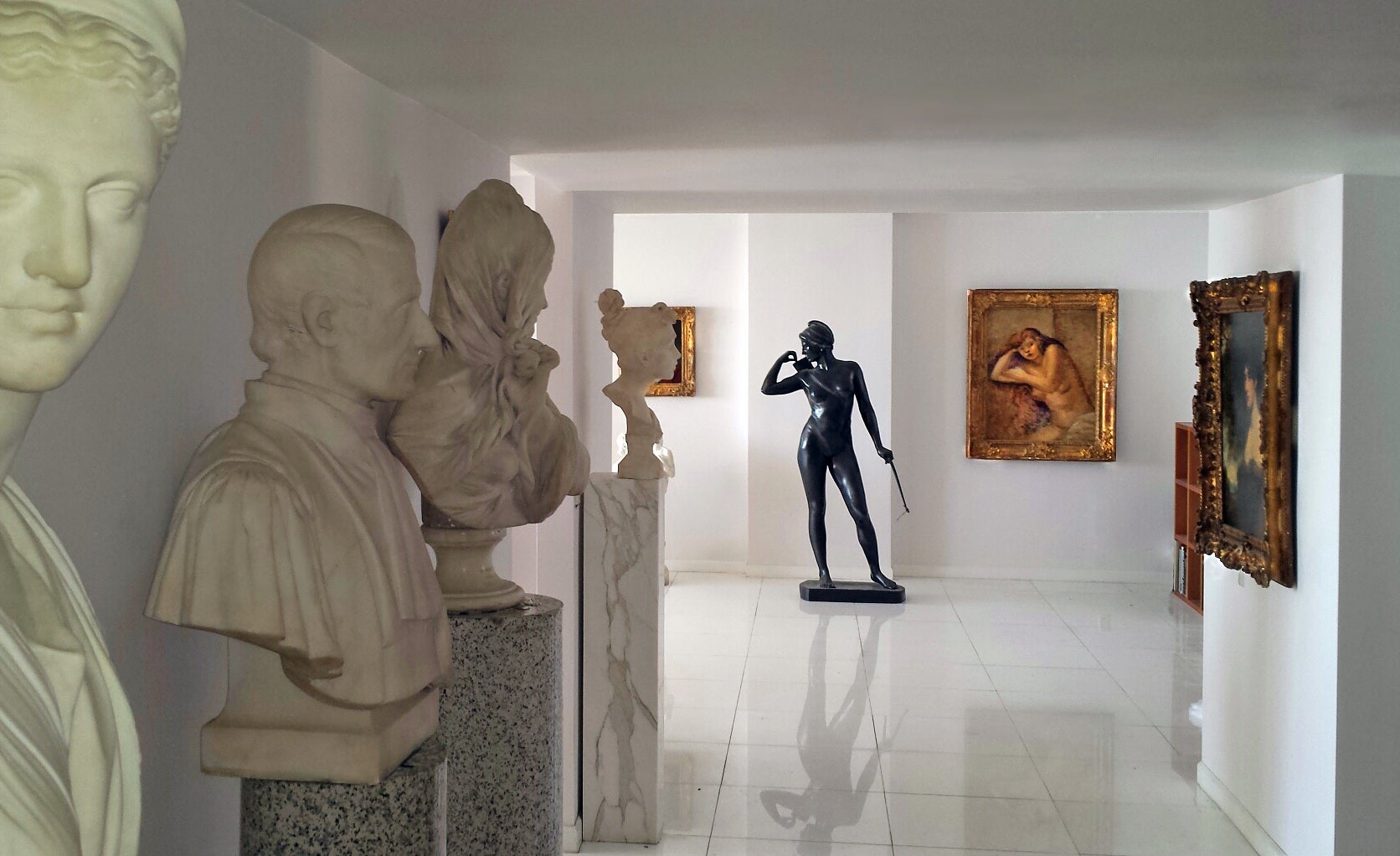
About the Seller
4.9
Gold Seller
Premium sellers maintaining a 4.3+ rating and 24-hour response times
Established in 2005
1stDibs seller since 2016
115 sales on 1stDibs
Typical response time: 1 hour
- ShippingRetrieving quote...Shipping from: Miami, FL
- Return Policy
Authenticity Guarantee
In the unlikely event there’s an issue with an item’s authenticity, contact us within 1 year for a full refund. DetailsMoney-Back Guarantee
If your item is not as described, is damaged in transit, or does not arrive, contact us within 7 days for a full refund. Details24-Hour Cancellation
You have a 24-hour grace period in which to reconsider your purchase, with no questions asked.Vetted Professional Sellers
Our world-class sellers must adhere to strict standards for service and quality, maintaining the integrity of our listings.Price-Match Guarantee
If you find that a seller listed the same item for a lower price elsewhere, we’ll match it.Trusted Global Delivery
Our best-in-class carrier network provides specialized shipping options worldwide, including custom delivery.More From This Seller
View AllStudious Girl Reading a Book - Women's Education - Female Illustrator
By Elizabeth Shippen Green
Located in Miami, FL
The work represents a carefully rendered and meticulously observed environmental portrait of a young girl absorbed in study in front of a book case. It celebrates the intelligence of womanhood from a woman's perspective. Initialed in cartouche lower right
literature: "The Silver Pencil", Hardy, Harper's Monthly, June 1912, pg. 22
Elizabeth Shippen Green (September 1, 1871 – May 29, 1954) was an American illustrator. She illustrated children's books and worked for publications such as The Ladies' Home Journal, The Saturday Evening Post and Harper's Magazine.
Education
Green enrolled at the Pennsylvania Academy of the Fine Arts in 1887 and studied with the painters Thomas Pollock Anshutz, Thomas Eakins, and Robert Vonnoh.[2] She then began study with Howard Pyle at Drexel Institute where she met Violet Oakley and Jessie Willcox Smith.
New Woman
As educational opportunities were made more available in the 19th century, women artists became part of professional enterprises, including founding their own art associations. Artwork made by women was considered to be inferior, and to help overcome that stereotype women became “increasingly vocal and confident” in promoting women's work, and thus became part of the emerging image of the educated, modern and freer “New Woman”.[4] Artists "played crucial roles in representing the New Woman...
Category
1910s Academic Figurative Drawings and Watercolors
Materials
Paper, Chalk, Charcoal
Portrait of a Woman lost in Thought
By Kenneth Hayes Miller
Located in Miami, FL
Signed and dated 1924 upper right
Simplified forms, geometricized volumes and restricted color palette characterizes this work.
Zabriskie Gallery Label on verso
Original period frame
Kenneth Hayes Miller taught at the Art Students League from 1911 until 1951. Some of his students were: Reginald Marsh, George Bellows, George Tooker, Rockwell Kent, Yasuo Kuniyoshi and Patrick Henry Bruce
Category
1920s American Impressionist Portrait Paintings
Materials
Oil
Charcoal Portrait of a Lady Profile - Partner of Violet Oakley - Gay Interest
Located in Miami, FL
Academic study in profile of a high bow sitter on gray paper with white highlights.
Signed lower right and dated faintly 1916
Edith Emerson (July 27, 1888 – November 21, 1981) was a...
Category
1910s Academic Portrait Drawings and Watercolors
Materials
Paper, Charcoal
Portrait of a Seated Woman
By Arthur Beecher Carles
Located in Miami, FL
Charming portait with Modernest colors.
Provenance: Christie's
Mercedes Matter, daughter of the artist, Salander-O'Reilly Galleries, New York. Private Collection. Sale: Skinner, Inc...
Category
1910s American Modern Portrait Paintings
Materials
Oil
Introspective Woman / Actress on Movie Set. Mid Century Art, Female Illustrator
By Lorraine Fox
Located in Miami, FL
Lorraine Fox was an American illustrator and commercial artist who illustrated magazines, book covers, and advertisements. Among the magazines, she illustrated for were Woman's Day, ...
Category
1960s Post-Impressionist Figurative Paintings
Materials
Watercolor, Gouache, Board, Pencil
The Court Ladies Dressed Gerda - Women Illustrators
Located in Miami, FL
Women illustrators were alive, well, and quite active in the early 20th century. Most of their production was associated with topics that dealt with the home, children or fairy tales. In this masterfully rendered work in pen and ink, Jacobs displays great technical skill in presenting three maidens dressing a beautiful female member of the Court wearing a tiara. Signed in a cartouche lower right
From: Stella Mead, Great Stories from Many Lands, London: James Herbert and Co, 1936, page 78 " Red and White Roses"
Provenance: Chris Beetles
Work is elegantly matted and not framed.
Helen Mary Jacobs was born in Ilford, Essex, the sister of the writer W.W. Jacobs; she studied art at the West Ham...
Category
1930s Art Nouveau Figurative Drawings and Watercolors
Materials
Ink, Pencil
You May Also Like
Seated Young Lady (by leader of "Southern Art Renaissance") - Antique Drawing
By Ellsworth Woodward
Located in New Orleans, LA
Many of you clicking on this pen-and-ink of a pretty Edwardian-era lady are probably doing so because you know of Ellsworth Woodward, who with his brother William Woodward around the...
Category
1890s Romantic Portrait Drawings and Watercolors
Materials
Ink
Study for a Seated Woman (by leader of "Southern Art Renaissance")
By Ellsworth Woodward
Located in New Orleans, LA
Many of you clicking on this wonderful pen-and-ink are probably doing so because you know of Ellsworth Woodward, who with his brother William Woodward around the turn of the 20th century sparked an arts renaissance in the South, the arts and culture in general having been mostly moribund since the dispiriting defeat experienced in the Civil War. I won't bog you down with lots of detail here since all you have to do is Google his name to bring up a wealth of information about him. He is most famous for his leadership of the arts program at Newcomb College in New Orleans, and its famous Newcomb Pottery...
Category
1890s Romantic Portrait Drawings and Watercolors
Materials
Ink
"Now that her chance was come, Janet seemed loath to speak."
By Alice Barber Stephens
Located in Fort Washington, PA
Story illustration for Janet: Her winter in Quebec by Anna Chapin Ray, published in 1906 by Little, Brown, and Company, facing page 200
The full caption reads: “Now that her chance ...
Category
Early 20th Century Interior Drawings and Watercolors
Materials
Charcoal, Board
Profile Portrait of a Woman Sitting on a Chair
Located in Stockholm, SE
A finely tuned oval drawing by the Finnish artist Ester Helenius depicting a young woman in profile seated on a chair. The room is suggested only by a diffuse background. Signed and ...
Category
1910s Jugendstil Portrait Drawings and Watercolors
Materials
Paper, Charcoal, Gouache
Pensive Young Woman
By Maurice Chabas
Located in Paris, Île-de-France
Maurice Chabas (Nantes 1862 – Versailles 1947)
Pensive Young Woman
Graphite with white-chalk highlights on blue-grey paper
46 × 32 cm
Unsigned
Provenance
Bruno Delarue Gallery, É...
Category
1890s Impressionist Portrait Drawings and Watercolors
Materials
Pencil, Chalk
“Seated Woman”
Located in Southampton, NY
Beautifully executed graphite on archival paper original drawing of a young woman seated by the American artist, William Sanders Fanning. Signe...
Category
1920s Post-Impressionist Figurative Drawings and Watercolors
Materials
Archival Paper, Graphite
$960 Sale Price
20% Off
More Ways To Browse
Quaker Chair
Ladies And Gentleman Chairs
Nursery Chair
Round Chestnut Table
Hawthorne Glass
Xiao Wen Xu
Grace Eichholz On Sale
Hugh Douglas Hamilton
Lanvin Cat
Louis Vuitton Rainbow Shirt
Marie Amelie Chautard Carreau
Xiao Wen Xu
Nathan Brad Hall
Nike Air Jordan 3
Georges Jules Ernest Binet
Monique Lhuillier Used
Grace Eichholz On Sale
Biggs And Sons
